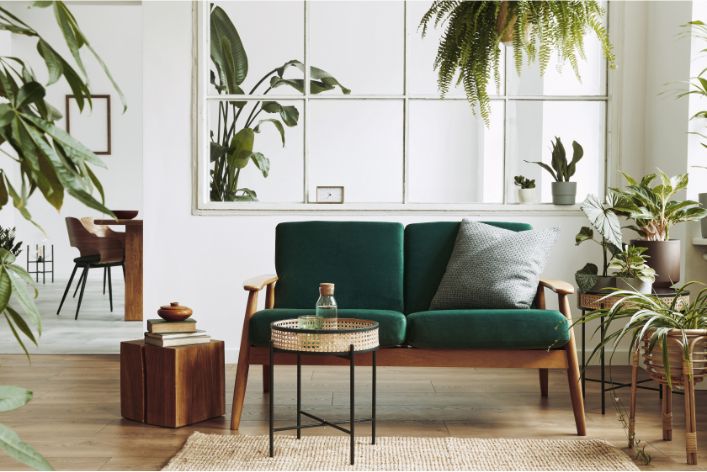Last Updated on May 10, 2023
Staging your home for a quick sale is a crucial step in the home selling process. An effectively staged home can create a lasting impression on potential buyers and increase the likelihood of a successful sale. In this blog post, we will explore the importance of home staging, its impact on the selling process, and provide an overview of the steps involved in staging your home for a quick sale.
Home staging is the art of preparing your home to appeal to a wide range of buyers by showcasing its best features and maximizing space utilization. A well-staged home can help your property stand out in a competitive market, ultimately leading to a quicker sale and potentially a higher selling price.

Throughout this blog post, we will delve into various aspects of home staging, including decluttering and cleaning, defining the purpose of each room, selecting a neutral color palette, depersonalizing your home, and choosing the right furniture and accessories. Additionally, we will discuss the importance of lighting and ambience, enhancing outdoor spaces and curb appeal, and working with a professional home stager.
By following the guidance provided in this blog post, you can transform your home into an inviting and buyer-friendly space that captures the interest of potential buyers. Embrace the staging process and experience the benefits of a quick and successful home sale. Let’s begin our journey towards a beautifully staged home!
Read: 10 Questions to Ask Your Landlord Before Signing a Lease
Preparing Your Home for Staging
Before diving into the actual staging process, it’s essential to prepare your home by decluttering, cleaning, and addressing any minor repairs and maintenance issues. This chapter will discuss the benefits of decluttering, offer tips for effective decluttering, explain the importance of deep cleaning and attention to detail, and highlight the significance of fixing visible issues and enhancing curb appeal.
A. Decluttering
Decluttering is a crucial first step in preparing your home for staging. A clutter-free environment not only makes your home appear more spacious and inviting but also allows potential buyers to focus on the property’s features. Here are some benefits of decluttering:
- Creates a sense of space
- Highlights your home’s best features
- Simplifies the moving process
- Reduces stress and enhances emotional well-being
To declutter effectively, follow these tips:
- Start early: Give yourself ample time to sort through your belongings and avoid feeling overwhelmed.
- Tackle one room at a time: Break the process into manageable tasks by focusing on individual spaces.
- Categorize items: Separate items into categories, such as keep, donate, sell, or discard.
- Utilize storage solutions: Consider investing in temporary storage units or utilizing off-site storage facilities.
- Be ruthless: Let go of items that you no longer need or use.
B. Cleaning
Next, deep cleaning your home is vital in creating a welcoming atmosphere for potential buyers. A clean home shows that the property has been well-maintained and cared for. To ensure a thorough cleaning, follow this checklist:
- Dust surfaces, including baseboards, crown molding, and light fixtures.
- Clean windows, both inside and out, for optimal natural light.
- Deep clean carpets, rugs, and upholstery to remove stains and odors.
- Sanitize high-touch areas, such as doorknobs and light switches.
- Pay attention to small details, like polishing faucets and wiping down appliances.
C. Minor repairs and maintenance
Lastly, addressing minor repairs and maintenance issues is crucial in demonstrating that your home is move-in ready. Fixing visible issues and enhancing curb appeal can significantly impact a buyer’s perception of your property. Here’s a list of tasks to consider:
- Patch holes and cracks in walls and ceilings.
- Repair or replace broken fixtures, such as faucets, door handles, and light switches.
- Address any plumbing or electrical issues.
- Touch up paint, both inside and outside the house.
- Ensure all doors and windows open and close smoothly.
Enhance your home’s curb appeal by:
- Mowing the lawn and trimming overgrown bushes.
- Adding colorful plants or flowers to your landscape.
- Pressure washing the exterior of the house, driveway, and walkways.
- Painting or staining the front door and updating the hardware.
- Adding or updating exterior lighting fixtures.
By decluttering, deep cleaning, and addressing minor repairs and maintenance, you set the stage for a successful home staging process. With a clean, well-maintained, and clutter-free environment, potential buyers will be able to envision themselves living in your home, increasing the likelihood of a quick and profitable sale.
Read: Home Staging: How To Stage Your Home For a Successful Open House
The Staging Process
Now that your home is decluttered, clean, and well-maintained, it’s time to dive into the staging process. This chapter will discuss defining the purpose of each room, selecting a neutral color palette, and depersonalizing your home to create an inviting environment for potential buyers.
A. Defining the purpose of each room
1. Maximizing space utilization
To create a lasting impression on buyers, ensure each room in your home serves a clear purpose. Consider the following tips:
- Remove unnecessary furniture or items that may obstruct pathways
- Arrange furniture in a way that highlights the room’s functionality
- Use multi-functional furniture, such as a storage ottoman or a bed with built-in drawers
- Keep countertops and surfaces clear to showcase the available space
2. Creating a balanced layout
A balanced layout allows potential buyers to navigate your home easily. Follow these guidelines:
- Arrange furniture symmetrically or asymmetrically to create visual harmony
- Avoid overcrowding by using appropriately-sized furniture
- Use area rugs to define separate spaces in open-concept layouts
- Allow for sufficient walking space between furniture pieces
B. Choosing a neutral color palette
1. The psychology of color
Colors can evoke various emotions and perceptions, which can influence a buyer’s decision-making process. Neutral colors are universally appealing and can:
- Create a calm and soothing atmosphere
- Make rooms appear more spacious and open
- Allow buyers to envision their own decor and personal touches
- Enhance the home’s architectural features and natural light
2. Tips for selecting the right colors
When choosing a neutral color palette for your home, consider these tips:
- Opt for warm neutrals, such as beige, cream, or light gray, to create a cozy environment
- Use white or off-white for trim and molding to add contrast and visual interest
- Choose a single neutral color for your entire home to create a sense of continuity
- Test paint swatches on walls to see how they look in different lighting conditions
C. Depersonalizing your home
1. Removing personal items
Depersonalizing your home allows potential buyers to envision themselves living in the space. Remove the following items:
- Family photos, diplomas, and certificates
- Personal collections, such as figurines, sports memorabilia, or souvenirs
- Religious or political items that may not resonate with all buyers
- Children’s artwork, toys, and personalized decor
2. Creating a blank canvas for potential buyers
To create a blank canvas that appeals to a wide range of buyers, follow these steps:
- Replace bold or patterned textiles with neutral, solid-colored options
- Choose simple, classic artwork that complements the overall decor
- Remove any themed or overly personalized room decor
- Use minimal and versatile accessories, such as vases, candles, and decorative pillows
By defining the purpose of each room, selecting a neutral color palette, and depersonalizing your home, you’ll create an inviting and appealing environment that captures the interest of potential buyers. These staging techniques will ultimately increase the likelihood of a quick and successful sale.
Read: How to Choose the Right Neighborhood for Your Next Home
Furniture and Accessories
With the foundation of your staged home in place, it’s time to focus on furniture and accessories. This chapter will explore selecting the right furniture, balancing comfort and style, and using accessories strategically to create a visually appealing and inviting environment for potential buyers.
A. Selecting the right furniture
1. The importance of scale and proportion
Properly scaled and proportioned furniture is crucial in creating a harmonious and balanced space. Keep these tips in mind:
- Choose furniture that fits the size of the room without overwhelming the space
- In smaller rooms, opt for compact furniture with clean lines and minimal visual weight
- Ensure ample space between furniture pieces to allow for easy navigation
- Vary the height and size of furniture items to create visual interest
2. Balancing comfort and style
When selecting furniture, it’s essential to strike a balance between comfort and style. Consider these guidelines:
- Opt for furniture with simple, timeless designs to appeal to a wide range of buyers
- Choose upholstery in neutral colors and versatile materials, such as linen or microfiber
- Prioritize comfort by incorporating plush seating, cozy textiles, and supportive cushions
- Use accent furniture, such as side tables or benches, to add functionality and style
B. Using accessories strategically
1. The power of accents
Accessories can enhance the overall aesthetic of your staged home, drawing attention to its best features. Use accents to:
- Add pops of color, texture, or pattern to a neutral space
- Highlight architectural details, such as built-in shelves or fireplace mantels
- Create a sense of depth and dimension in a room
- Bring warmth and personality to the space without overwhelming it
Here are some accessory ideas:
- Decorative pillows in varying textures and patterns
- Table lamps, floor lamps, or pendant lights for added ambiance
- Framed artwork or mirrors to fill empty wall space
- Plants or fresh flowers to bring life and color to the room
2. Creating focal points
Focal points serve as visual anchors that draw the eye and make a room feel complete. To create a focal point:
- Arrange furniture around a central element, such as a fireplace, large window, or statement artwork
- Use a bold accessory, such as a unique sculpture or colorful area rug, to capture attention
- Highlight architectural features with contrasting colors or materials
- Create a feature wall with an accent color, textured wallpaper, or a gallery wall of artwork
By selecting the right furniture and using accessories strategically, you can create an inviting and well-balanced space that appeals to potential buyers. Incorporating accents and focal points will add visual interest and depth to your home, increasing its attractiveness and, ultimately, the likelihood of a quick sale.
Read: The Pros and Cons of Renting vs Buying a Home
Lighting and Ambience
A well-staged home not only relies on furniture and accessories but also on creating the right lighting and ambience. This chapter will discuss the role of lighting in home staging, different types of lighting, and how to create an inviting atmosphere for potential buyers.
A. The role of lighting in home staging
1. Enhancing the room’s atmosphere
Proper lighting can significantly impact the overall atmosphere of your home. Effective lighting can:
- Make rooms appear larger, brighter, and more inviting
- Highlight architectural features and focal points
- Create a warm and cozy environment that appeals to buyers
- Improve the overall aesthetic and functionality of the space
2. Types of lighting
To create a well-lit space, incorporate these three types of lighting:
- Ambient lighting: Provides general illumination and sets the tone for the room. Examples include ceiling-mounted fixtures and recessed lighting.
- Task lighting: Focuses on specific areas where tasks are performed, such as under-cabinet lights in the kitchen or a desk lamp in a home office.
- Accent lighting: Highlights architectural features, artwork, or focal points. Examples include track lighting, wall sconces, or uplighting.
B. Creating an inviting ambience
1. The importance of temperature and scent
Temperature and scent play significant roles in creating an inviting atmosphere. Consider these factors:
- Temperature: Ensure your home is comfortable during showings by adjusting the thermostat to an appropriate level. Aim for around 70°F (21°C) to cater to most preferences.
- Scent: Use subtle, pleasant scents to create a welcoming environment. Avoid strong or overpowering fragrances that may deter potential buyers. Opt for scents like citrus, lavender, or vanilla.
2. Tips for setting the right mood
To create a welcoming and comfortable atmosphere, follow these tips:
- Maximize natural light: Open blinds and curtains to let in as much natural light as possible. Clean windows to ensure they are free of smudges and dirt.
- Layer your lighting: Combine different types of lighting to create a well-lit space that caters to various needs and preferences.
- Add dimmer switches: Installing dimmer switches allows you to adjust the brightness of your lighting to create a cozy and inviting atmosphere.
- Use mirrors strategically: Place mirrors opposite windows or light sources to reflect light and make rooms appear larger and brighter.
- Incorporate soft textiles: Use plush rugs, throw blankets, and decorative pillows to create a cozy and comfortable environment.
By focusing on lighting and ambience, you can transform your home into a welcoming and appealing space that captures the interest of potential buyers. The right combination of lighting types, temperature, and scent can significantly impact the overall atmosphere of your home, increasing its attractiveness and ultimately contributing to a quick and successful sale.
Read: What to Look for in a Home Inspection Report
Outdoor Spaces and Curb Appeal
In addition to creating a beautifully staged interior, it’s essential not to neglect the exterior of your home. This chapter will discuss the impact of landscaping and gardening on potential buyers and provide easy tips for enhancing curb appeal.
A. Landscaping and gardening
1. The impact of greenery on potential buyers
Well-maintained outdoor spaces can have a significant impact on potential buyers by:
- Creating a welcoming and attractive first impression
- Demonstrating pride of ownership and attention to detail
- Increasing the perceived value of your home
- Offering additional living and entertaining space
2. Easy landscaping tips
To improve your home’s landscaping and gardening, consider the following tips:
- Mow the lawn regularly and keep edges neat and trimmed
- Remove dead plants and weeds, and prune overgrown shrubs or trees
- Add mulch to garden beds for a polished look and to retain moisture
- Plant colorful annuals or perennials to add visual interest and curb appeal
- Use container plants to create focal points or define outdoor spaces
B. Enhancing curb appeal
1. The importance of first impressions
Curb appeal is crucial in creating a positive first impression for potential buyers. A well-maintained exterior can:
- Attract more buyers and increase foot traffic during showings
- Set your home apart from the competition
- Encourage buyers to explore the interior of your home
- Contribute to a quicker sale and potentially higher selling price
2. Ideas for improving curb appeal
To enhance your home’s curb appeal, consider these suggestions:
- Paint or clean the front door, and update hardware if needed
- Pressure-wash the siding, walkways, and driveway for a clean and refreshed appearance
- Replace or repair damaged or missing house numbers, mailboxes, or exterior lighting fixtures
- Add window boxes or potted plants to brighten up your home’s facade
- Create an inviting entrance with a welcome mat, seasonal wreath, or decorative bench
By focusing on landscaping, gardening, and curb appeal, you can create a welcoming and visually appealing exterior that attracts potential buyers. A well-maintained outdoor space demonstrates pride of ownership and attention to detail, increasing the likelihood of a quick and successful sale. Remember, a positive first impression is key in the home selling process, so invest time and effort into enhancing your home’s exterior to maximize its appeal.
Read: Maximizing Your Home’s Value: Top Renovations to Consider
Working with a Professional Home Stager
Although staging your home may seem like a daunting task, working with a professional home stager can simplify the process and yield impressive results. This chapter will discuss the benefits of hiring a professional, tips for selecting the right home stager, and how to collaborate effectively.
A. The benefits of hiring a professional
Choosing to work with a professional home stager offers several advantages:
- Expertise: A professional stager possesses the knowledge and experience to transform your home into an appealing space for buyers.
- Objectivity: A stager can view your home from a buyer’s perspective, identifying areas for improvement and making unbiased recommendations.
- Time and effort: Staging a home can be time-consuming, but a professional can streamline the process and save you energy.
- Resources: A home stager has access to furniture, accessories, and other resources that may not be readily available to you.
- Increased value: A well-staged home often sells faster and for a higher price, making the investment worthwhile.
B. Tips for selecting the right home stager
To find a reputable and qualified home stager, consider the following tips:
- Research: Look for stagers with positive reviews, testimonials, and a strong online presence. Ask for recommendations from friends or your real estate agent.
- Portfolio: Review the stager’s portfolio to assess their style, versatility, and attention to detail.
- Certification: Check if the stager has completed professional training or certification in home staging or a related field.
- Budget: Discuss your budget upfront and inquire about the stager’s fees and services. Obtain quotes from multiple stagers for comparison.
- Communication: Choose a stager who listens to your needs and communicates effectively to ensure a successful collaboration.
C. Collaborating with a home stager
To maximize the benefits of working with a professional home stager, follow these guidelines:
- Be open-minded: Listen to the stager’s recommendations, even if they involve removing cherished belongings or making significant changes.
- Communicate your goals: Share your expectations, timeline, and budget with the stager to ensure a smooth process.
- Stay involved: While the stager will take the lead, remain engaged in the process and provide feedback when necessary.
- Ask questions: Don’t hesitate to ask for clarification or advice on any aspect of the staging process.
- Trust their expertise: Remember that the stager is a professional with experience in creating spaces that appeal to buyers. Trust their judgment and expertise.
By working with a professional home stager, you can leverage their knowledge, experience, and resources to create an inviting and appealing space that attracts potential buyers. Selecting the right stager and collaborating effectively will not only simplify the staging process but also increase the likelihood of a quick and successful sale.
Read: Eco-Wonder Homes Soar: Exciting Green Real Estate Movement
Conclusion
On a final note, staging your home effectively can significantly impact the sale of your property, leading to a quicker and more profitable transaction. This blog post has outlined the essential steps to stage your home successfully and create an inviting, buyer-friendly environment.
A. Recap of the staging process
To ensure a well-staged home, follow these key steps:
- Prepare your home by decluttering, cleaning, and addressing minor repairs
- Define the purpose of each room and create a balanced layout
- Choose a neutral color palette to appeal to a wide range of buyers
- Depersonalize your home, removing personal items to create a blank canvas
- Select the right furniture and accessories to enhance the space
- Focus on lighting and ambience to create a welcoming environment
- Improve your outdoor spaces and curb appeal to make a strong first impression
- Consider working with a professional home stager to maximize results
B. The potential impact on the sale of your home
By implementing these staging strategies, you can:
- Attract a larger pool of potential buyers
- Create a positive and memorable first impression
- Highlight your home’s best features and increase its perceived value
- Set your property apart from the competition
- Accelerate the selling process and potentially secure a higher selling price
C. Encouragement to take action
Now that you’re equipped with the knowledge and strategies for staging your home, it’s time to take action. By investing time and effort into the staging process, you can create a visually appealing and inviting space that captures the interest of potential buyers.
Remember, the ultimate goal is to make your home stand out in the competitive real estate market and maximize its potential for a successful and profitable sale. With the right approach and attention to detail, you can transform your home into a buyer’s dream and achieve the results you desire. Good luck, and happy staging!
Read: Who is a Real Estate Developer?
Before You Go…
Hey, thank you for reading this blog to the end. I hope it was helpful. Let me tell you a little bit about Nicholas Idoko Technologies. We help businesses and companies build an online presence by developing web, mobile, desktop, and blockchain applications.
We also help aspiring software developers and programmers learn the skills they need to have a successful career. Take your first step to become a programming boss by joining our Learn To Code academy today!
Be sure to contact us if you need more information or have any questions! We are readily available.








